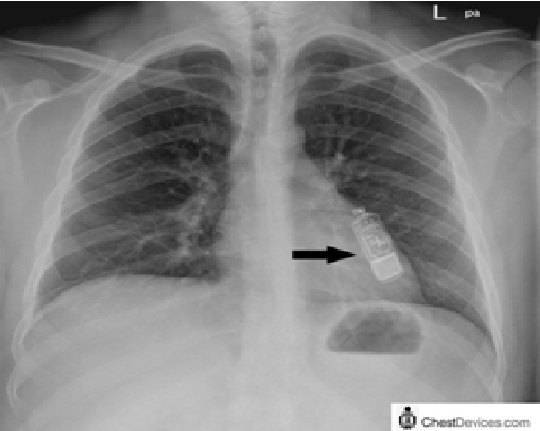
An implantable loop recorder is a medical device that is placed beneath the skin in the chest to record data about heart events over a long period of time – up to two years. This type of monitoring can help diagnose someone who has infrequent symptoms.
How Does It Work?
An implantable loop recorder, like a Holter monitor and event monitor, reads your heart’s electrical activity. Your heart has an electrical system that functions like a natural pacemaker. Electrical signals travel through the chambers of the heart to cause it to beat. If the heart’s natural electrical system is not functioning correctly, an abnormal heartbeat (arrhythmia) may result.
The implantable loop recorder continuously monitors the electrical activity of the heart and automatically begins recording information when the heart’s patterns change. Alternately, you may be instructed by your physician to turn on the device’s recording function by using an external“activator,” a hand-held device that you hold over the site on your chest where the recorder has been implanted.
How Does It Work?
An implantable loop recorder, like a Holter monitor and event monitor, reads your heart’s electrical activity. Your heart has an electrical system that functions like a natural pacemaker. Electrical signals travel through the chambers of the heart to cause it to beat. If the heart’s natural electrical system is not functioning correctly, an abnormal heartbeat (arrhythmia) may result.
The implantable loop recorder continuously monitors the electrical activity of the heart and automatically begins recording information when the heart’s patterns change. Alternately, you may be instructed by your physician to turn on the device’s recording function by using an external“activator,” a hand-held device that you hold over the site on your chest where the recorder has been implanted.
How Is It Performed?
An implantable loop recorder is inserted by an electrophysiologist, a physician who specializes in the heart’s electrical system. The procedure is performed in the hospital under local anesthesia. The device, which is about the size of a flattened AA battery, is implanted through an incision in the chest, which is closed with stitches after implantation of the device. You can typically return home and to normal activity the same day.
Your physician will be able to view data from the recorder on a specialized computer. After a diagnosis has been made, or at the end of the device’s battery life, the recorder may be removed in a procedure very similar to the one used for insertion.
Is It Safe?
Receiving an implantable loop recorder is a very safe procedure. Rarely, patients may experience infection at the insertion site. However, an implantable loop recorder, unlike a pacemaker, does not have wires (leads) directly into the heart, so it does not present a risk of infection from that standpoint.
An implantable loop recorder is inserted by an electrophysiologist, a physician who specializes in the heart’s electrical system. The procedure is performed in the hospital under local anesthesia. The device, which is about the size of a flattened AA battery, is implanted through an incision in the chest, which is closed with stitches after implantation of the device. You can typically return home and to normal activity the same day.
Your physician will be able to view data from the recorder on a specialized computer. After a diagnosis has been made, or at the end of the device’s battery life, the recorder may be removed in a procedure very similar to the one used for insertion.
Is It Safe?
Receiving an implantable loop recorder is a very safe procedure. Rarely, patients may experience infection at the insertion site. However, an implantable loop recorder, unlike a pacemaker, does not have wires (leads) directly into the heart, so it does not present a risk of infection from that standpoint.
Cardiac Specialty Care
• Structural Heart Disease
• TAVR Aortic Valve
• Cardiomem - Heart Failure
• Coronary Disease
• TAVR Aortic Valve
• Cardiomem - Heart Failure
• Coronary Disease
• Complex total Occlusions
• Stent and PTCA
• Atherectomy
• Cerebral
• Stent and PTCA
• Atherectomy
• Cerebral
• Carotid Stenting
• Peripheral Arterial
• Atherectomy-Stent-Thrombectomy
• Peripheral/Venus - Ablation - DVT thrombectomy - IVC filter
• Peripheral Arterial
• Atherectomy-Stent-Thrombectomy
• Peripheral/Venus - Ablation - DVT thrombectomy - IVC filter
• Rhythm Management
• Pacemaker
• Resynchronization Therapy
• EECP- Enhance electrical Counterpulsation
• Pacemaker
• Resynchronization Therapy
• EECP- Enhance electrical Counterpulsation
